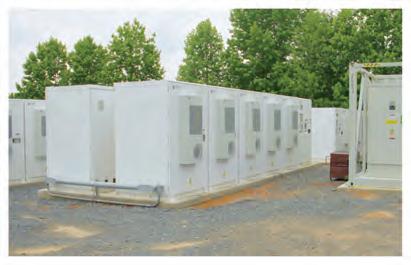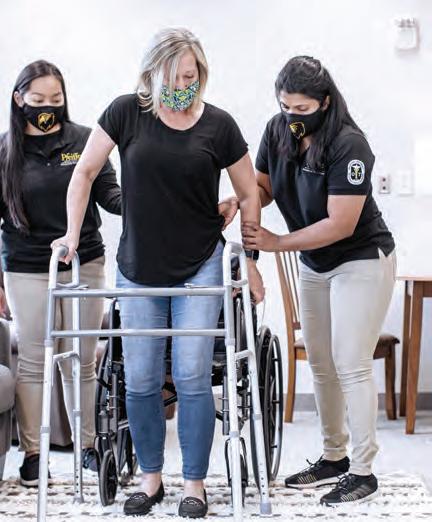
21 minute read
More Power
from 2023-02-PEMC
Wake Electric’s Privette Posthumously Awarded Order of the Longleaf Pine
Late director’s family received the award on his behalf
On Dec. 8, former Wake Electric Director Rodney Privette was posthumously awarded the Order of the Long Leaf Pine. Since 1963, North Carolina’s governors have reserved the award as the highest honor for persons who have made significant contributions to the state and their communities through exemplary service and exceptional accomplishments.
Privette passed away unexpectedly in August. He had served on the Wake Electric Board of Directors since March 2016. The award was presented to Privette’s family by NC Senator Sarah Crawford and NC Representative Terence Everitt. Donnie Lawrence, current chief of the Rolesville Rural Fire Department, coordinated the presentation, which coincided with the annual meeting for the fire department.
“Rodney’s impact on our community is an inspiring example of leadership to everyone who knows him,” said Wake Electric Board President Suzy Morgan. “As a Rolesville native, Rodney’s community ties ran deep, and Wake Electric celebrates the mark he left on the cooperative as well as public safety and economic development in our area.”
In addition to serving on the Wake Electric Board of Directors, Privette had served as chief of the Rolesville Rural Fire Department since 1992 where he had begun as a volunteer firefighter in 1975. He also served on the Wake County Fire Commission, helped form the Rolesville Chamber of Commerce, served on the board of the Wake Forest Federal Savings & Loan and co-owned Privette Insurance Agency with his sister. He was also a devoted, lifelong member of the Rolesville Baptist Church.
(L to R) Privette’s family receiving the award were fiancée Susan Cashion; daughter Brandi Privette and her fiancé Kevin; Niki Privette and grandsons Carson, Hunter and Andrew, and son Coy Privette. NC Sen. Crawford and NC Rep. Everitt presented the award.
In his spare time, Privette would restore old cars, including a 1965 Plymouth Barracuda that was once owned by a U.S. Army soldier who died in Vietnam (“The Compassionate Collector,” May 2020, page 14).


Students: Apply Now for Basketball Camp!
Rising sixth and seventh graders can now apply for a Touchstone Energy Sports Camp Scholarship to attend basketball camp in June. Wolfpack Women’s Basketball Camp NC State University Raleigh Carolina Basketball School The University of North Carolina Chapel Hill
Powering A Brighter Future
North Carolina’s Electric Cooperatives are enhancing reliability and advancing our service to consumer-members with cutting-edge technology as part of our Brighter Future vision.




Learn about our 5 microgrids, 10 battery energy storage systems, 13 solar + storage sites and more.
rural A fresh start for healthcare

Training the next generation of rural doctors
By Sarah Thompson
Before Cannon Memorial Hospital’s labor and delivery unit closed in 2015, Dr. Benjamin Gilmer delivered one of the last babies to be born in an Avery County hospital. The unit where his cousins were born is gone because it was no longer seen as cost-effective to provide obstetrical care in the county, Dr. Gilmer explains.
Dr. Gilmer is the medical director of the Rural Health Initiative and Rural Fellowship at the Mountain Area Health Education Center (MAHEC), the largest of nine area health education centers in the state, which address the supply, retention and quality of health professionals, particularly in rural communities. Before joining MAHEC, he lived and worked as a doctor in rural North Carolina. He believes that inspiring the next generation of doctors is the best way to help rural places not only survive, but attain health literacy and gain access to specialized doctors educated on social justice in health advocacy.
Counties in need The North Carolina Institute of Medicine describes primary care providers as “the entry point into the health care system.” Access to their care is associated with fewer health disparities and better health among various socioeconomic statuses. The target primary care provider to population ratio should be equal to roughly 6.6 providers per 10,000 patients, according to the Institute. This ratio symbolizes how access to providers improves overall health of communities and can prevent a diagnosis or injury from becoming a NC Primary Care Physicians 2021, by county Greater than recommended minimum of 6.67 per 10,000 patients Below the recommended minimum critical health issue. Yet many rural counties in North Carolina fall far short of this ratio (see map). The gap between access to health providers in rural versus urban counties is not just an inconvenience, it’s causing serious health disparities that doctors like Benjamin Gilmer want students to understand — and want to change.

Rural training Dr. Crystal Gaddy worked in rural healthcare systems for more than 18 years. She has witnessed its shortfalls firsthand. Today, she is an associate professor at Pfeiffer


University’s Master of Science in Occupational Therapy program in Stanly County, where she and other faculty echo the significant need for students to practice medicine in rural areas.
“We’re able to, along with other faculty, really teach and educate our students with the hopes that they will, at least initially or at sometime within their careers, serve those who are really underserved,” Dr. Gaddy says. “From the moment the students enter Pfeiffer’s Occupational Therapy Program, that is the main focus.”
Pfeiffer University’s graduate program in Occupational Therapy (OT) began about two years ago alongside their Physician Assistant (PA) Studies program. As their brandnew building started construction and faculty got together to discuss curriculums, rural health was always a part of the conversation. The most pressing issue discussed was the shortage of health providers in rural regions.
Assistant Professor of Physician Assistant Studies and Randolph EMC member Dale Patterson says that it is extremely difficult to keep providers in rural places. When he’s not at the university, Dale continues to provide clinical care once a week in his local county, Montgomery. At Pfeiffer, students learn about the need for their skills in rural areas, but also the unique opportunities that practicing and living in a rural community can bring.
Students discover this for themselves during their required fieldwork. Both the OT and PA programs place students across the country, and the world, to work with health providers and experience what it means to serve and be a part of a community. Dr. Gaddy believes that rural fieldwork is where students get the chance to show off their creativity and critical thinking.
“The best place to be creative is within rural healthcare,” Dr. Gaddy says. “When you have access to everything in the world, you don’t have to critically think as hard. With our students — with us trying to push them within those fieldwork areas and those opportunities in places we call ‘emerging areas’ — it shows them that anything is possible.”
Universities and rural health organizations try to motivate students to practice in rural areas through scholarships, loan forgiveness and other incentives. When Dale was in school, he received a National Health Service Corps scholarship and advises his students to take advantage of those opportunities, which give them more financial freedom to serve communities in need.
Desiring the work Back in Western North Carolina, Dr. Gilmer works 60 to 80 hours a week trying to recruit the newest generation of doctors to practice in rural places. Over the past five years, they’ve placed approximately 30 doctors in western regions of the state. The Rural Health Initiative (RHI) has become the largest recruiter of the health professionals in the mountains and are busy looking to place more psychiatrists, general surgeons and obstetricians.
Like Pfeiffer, Dr. Gilmer advises students to look for avenues of support that can ease their transition into rural health systems. He explains the three pillars of support that RHI utilizes to attract and retain health professionals in western North Carolina. First, they talk with high school students to inspire them to give back to their community by becoming a rural care provider. Second, they recruit, train and support students through their schooling by providing scholarships, special training for rural care and connecting them with communities early on. Third, they support practices so that they feel well-capacitated and that they’re a part of a much larger mission.
Hope for the future The work is exhausting yet rewarding. Doctors and local citizens are dedicating their lives to advocate and save lives in rural communities because they know everyone deserves the best care, no matter where they live. These advocates of rural healthcare find solace in those they work with and in the changes they’re seeing in the eyes of their students, patients and communities.
Dr. Benjamin Gilmer
Corey Nolen

Sarah Thompson was a Carolina Country editorial intern in 2022. She is currently pursuing a journalism degree from UNC Chapel Hill.


Alan Cradick Stephen Hayes


Cameron Art Museum
Marching Toward Freedom
Stephen Hayes honors Black history through sculpture
By Vanessa Infanzon
In 2019, the Cameron Art Museum approached Durham-resident and sculptor Stephen Hayes about memorializing the United States Colored Troops (USCT) who marched through Wilmington during the Civil War Battle of Forks Road in 1865. Stephen accepted the challenge to create the memorial.
Stephen’s creation — “Boundless,” a life-size bronze statue of 11 African American men — was unveiled in November 2021 on the grounds where the Battle of Forks Road was fought. The permanent exhibit is also the focal point at the only park in the nation built to honor the United States Colored Troops and their fight for freedom.
In the early stages of developing sketches for the sculpture, Stephen immersed himself in the history of the battle by walking the site and meeting the United States Colored Troops reenactors from Battery B 2nd United States Colored Light Artillery, USCT 35th Regiment Tryon Palace New Bern, and the 5th USCT Company C. While in character, these men gave Stephen a history lesson explaining what it was like to march and what kinds of clothing and shoes were worn. These soldiers didn’t have the benefit of making the trek on horses.
Each soldier’s face is based on a real person. At Stephen’s request, the museum put out a call for descendants of the soldiers and reenactors to pose for the sculpture. Stephen casted their faces, using plaster gauze to capture the details in a mold which would later be filled with plaster. The hands were cast from another group of people, veterans and additional descendants of the soldiers.
Unlike most monuments, Stephen intentionally placed “Boundless” on the ground, not on a pedestal. He wants viewers to question how this monument speaks to ones they’ve seen mounted on a tall platform.
Once the plaster mold was ready, Stephen reached out to Carolina Bronze Sculpture, Inc., in Seagrove about casting the piece in bronze. The large multifigure casting was complex, says Ed Walker, president of Carolina Bronze. He and Stephen worked closely together.
“(Stephen) is a visionary,” Ed says. “He can create pieces that have strong statements about societal changes, especially about the plight of African American people. He’s highly respected in my book in his ability to convey those types of images so that people can view and experience his sculpture, and lead with a new sensibility about important social issues.”
Vanessa Infanzon moved to Charlotte for college and never left. When she’s not writing about business or travel, she’s paddle boarding on the Catawba River.
Connection
PIEDMONT ELECTRIC COOPERATIVE MEMBER NEWSLETTER | FEBRUARY 2023
Navigating Supply Chain Issues

The electric utility industry has not been immune from supply chain issues. However, you can rest assured that Piedmont Electric Cooperative has the supplies it needs to continue to provide you with the first class service you have come to expect.
Meter Project Slows
Supply chain issues have had the biggest impact on our ability to complete the meter exchange process we began last year. Manufacturing constraints have delayed the delivery of the remaining meters we need to complete the project. We expect to receive the final batch of meters we need in the spring. While we currently have enough meters to maintain both our new and legacy system, the delay in the delivery of new meters will push the project’s completion into late summer or early fall. In operation for nearly 50 years, TEMA uses the collective buying power of North Carolina’s 26 electric cooperatives to secure better pricing for equipment, to diversify the number of suppliers and to help ensure that Piedmont Electric can continue to deliver the affordable, reliable electricity with the level of service you know.
Even in a time when costs are rising, this partnership saves the cooperative money while providing the materials we need to build and maintain our system. IMPORTANT DATES
February 14
Valentine’s Day March 31
Basketball Camp Applications Due College Scholarship Applications Due
12 Find Your Perfect Match 13 How Your Dollar is Spent 14 Medical Power Needs
During Outages
Critical Infrastructure
Cooperation among cooperatives, one of our core seven principles, helps us bolster our supply lines, strengthen our service to our members and protect us from many of the supply chain issues other industries are facing. Piedmont Electric is a part of a regional group of cooperatives that formed the Tarheel Electric Membership Association (TEMA), a material supply organization for North Carolina’s electric cooperatives.
Maximize Savings on Your Energy Bill
Flip the page to find out which Piedmont program is your perfect match so you can start saving more money each month.
Find Your Perfect Match
Love is in the air… and so are savings! Whether you’re lucky in love or still searching for that special someone, your perfect match is out there in the form of one of our convenient energy-saving programs that can help you save on your monthly bill.
We’ve developed a short, one-minute quiz you can take to get personalized recommendations about which Piedmont money-saving programs could be the best match for you. The quiz will help you think through your energy goals and ask you questions about how you currently use energy.

Depending on your lifestyle, routine and energy habits, some of our energy-saving programs will work better for you than others. For example, if you work from home, our time-of-day rate can help you save money by offering you a lower rate when you use energy during off-peak times. Or, if you got a new electric vehicle to help you kick off the new year on a “green foot,” our EV time-ofday rate could be just what you need. Answering Piedmont Electric’s quiz questions will take all the guesswork out of it, so you’ll know exactly which programs will make the biggest impact on your specific bill. Once you’ve answered the questions, technology will work its magic, calculating which programs you should consider joining. The process is quick and easier than scrolling through your favorite smartphone apps.
So, what will it be? Is your perfect match our time-of-day rate? Or maybe it’s our smart thermostat savings program? There’s only one way to find out. Head to pemc.coop/my-piedmont-programs today to take the quiz and learn which program you’re sure to love. If you have any questions, please feel free to call us at 800.222.3107.
SmartHub Makes It Even Easier to Track Your Savings
Once you’ve taken the quiz and signed up for your perfect match, don’t forget to create a SmartHub account if you haven’t already. SmartHub makes it easier than ever to keep tabs on your energy usage so you can get more insight into how joining our programs can impact the amount on your bill. Visit pemc.smarthub.coop to get started.
How Your Dollar Is Spent*
Thanks to the cooperative structure, we don’t answer to investors or shareholders. Instead, we answer to you, our member-owners. As such, we think it’s important that you know exactly how your dollars are spent when you pay your monthly electricity bill. The easiest way to do this is by breaking down the percentage of where each dollar goes from our members.
MEMBER SERVICE, SALES AND ACCOUNT MAINTENANCE: 7.2%
THE COST OF POWER: 50.3%
DEPRECIATION COSTS: 12%
ADMINISTRATIVE EXPENSE: 3.6%
By far, our biggest expense as a cooperative is the cost of purchasing power and is one of the areas where we have seen the biggest upward pressures on price. However, when we work collectively to lower our energy use on high-demand days, we can lower our wholesale power costs as well. Then, all of our dollars will go further as a result. Our other costs help us effectively run our cooperative. Our top priority is to provide our members with safe and reliable power. To do this, we spend money to maintain the power grid, restore power during outages, offer member services and return capital credits to our members. We also account for interest, taxes, depreciation and the administrative costs of running our co-op. Every portion of every dollar spent is an investment in our members and is approved by our board of directors. At a time when it feels like we’re all getting less for more, we hope you feel confident that Piedmont Electric is working to make your dollar go further. We truly thank you for being a member.
NET MARGINS: 8%
OPERATIONS AND MAINTENANCE: 14.4%
INTEREST ON BORROWED MONEY: 4.5%
Medical Power Needs During Outages
If you are a Piedmont Electric Cooperative member with a medical condition or use medical equipment that is dependent on having electricity, it is important to know how Piedmont Electric handles your situation in relation to power outages.
In the case of a power outage, Piedmont Electric will make every effort to respond to your needs. However, we cannot guarantee that we will restore electricity in a manner that would not threaten your dependence on medical equipment or would accommodate your medical condition. Therefore, it is of the utmost importance that you have a back-up plan to temporarily relocate to another location with electricity or have a standby power generator to accommodate your needs during prolonged power outages.
Piedmont Electric attempts to contact all members prior to planned outages or disconnections for non-payment. Make sure your phone number and email are up-to-date to ensure we can reach you ahead of these potential events and so that you will have time to plan accordingly. Verify your contact information on SmartHub or contact us at 800.222.3107.

STATEMENT OF NON-DISCRIMINATION
In accordance with Federal civil rights law and U.S. Department of Agriculture (USDA) civil rights regulations and policies, the USDA, its Agencies, offices and employees, and institutions participating in or administering USDA programs are prohibited from discriminating based on race, color, national origin, religion, sex, gender identity (including gender expression), sexual orientation, disability, age, marital status, family/parental status, income derived from a public assistance program, political beliefs or reprisal or retaliation for prior civil rights activity, in any program or activity conducted or funded by USDA (not all bases apply to all programs). Remedies and complaint filing deadlines vary by program or incident. Persons with disabilities who require alternative means of communication for program information (e.g., Braille, large print, audiotape, American Sign Language, etc.) should contact the responsible Agency or USDA’s TARGET Center at (202) 720-2600 (voice and TTY) or contact USDA through the Federal Relay Service at (800) 877-8339. Additionally, program information may be made available in languages other than English. To file a program discrimination complaint, complete the USDA Program Discrimination Complaint Form, AD-3027, found online at http://www.ascr.usda.gov/complaint_filing_ cust.html or at any USDA office, or call (866) 632-9992 to request the form. You may also write a letter containing all the requested information in the form. Send your completed complaint form or letter to the USDA by: 1. Mail: U.S. Department of Agriculture,
Director, Office of the Assistant
Secretary for Civil Rights 1400 Independence Avenue, SW,
Washington, D.C. 20250-9410 2. Fax: (202) 690-7442 3. Email: program.intake@usda.gov
Piedmont Electric Membership Corporation is an equal opportunity provider and employer.
PIEDMONT ELECTRIC CONNECTION
Published monthly for the members of Piedmont Electric Cooperative. Piedmont Electric Cooperative is an equal opportunity provider and employer.
Hillsborough and Roxboro Drive-Thru Hours: Tuesday,Wednesday and Thursday 8 a.m.-5 p.m. Caswell Drive-Thru Hours: Wednesday 8 a.m.-5 p.m. Offices are closed except for scheduled appointments. Available by phone Monday-Friday, 8 a.m. to 5 p.m. Report outages, make payments and access account information by phone 24-hours-a-day by calling 800.222.3107. Voice instructions will direct you through the system. 2500 NC Highway 86 South PO Drawer 1179 Hillsborough, NC 27278 Stephen B. Hamlin President & General Manager
DIRECTORS
Bill R. Barber, Chair Randy Kinley, Vice Chair David Poythress, Secretary Richal Vanhook, Treasurer Steven P. Bailey, Stephen C. Long, V. Kay Scurlock-Ferguson, Elizabeth Townsend & Cyrus Vernon
IF YOUR POWER GOES OUT, CALL OR TEXT 800.222.3107
Opt in for text alerts by texting “pemc” to 800.222.3107. Once you’ve opted in, report an outage by texting “#out” to 800.222.3107 or "#status" for an update on your outage. Our automated outage reporting system uses your phone number to determine your service location. Update the phone number connected to your account online through SmartHub, by completing the form on your monthly bill or by calling 800.222.3107.
Use the SmartHub app to report an outage or online at pemc.smarthub.coop/#reportanissue: with your SmartHub login. Please note that it may take up to 24 hours for our system to recognize new cell phone numbers in the text outage alert program.
Treasure Memories in Corolla.
With families reserving 2023 accommodations earlier than ever, there’s never been a better time to find the perfect place for your spring or summer getaway. It is nice to know that awe-inspiring remote beaches, legendary wild horses and iconic historical sites are here for you to treasure on the Corolla Outer Banks.

Find shopping, dining and entertainment with the new Corolla OBX Mobile App, on the App Store and Google Play.
Ready To Explore Corolla, NC
Land of Legendary Wild Horses
Just North of where paved roads come to an end on the Outer Banks is where the official state horse of North Carolina roam. The legendary Corolla wild horses have been calling our beaches home for over 400 years.
The Currituck Beach Lighthouse
A beacon helping guide travelers for well over a century, the Currituck Beach Lighthouse towers over the Outer Banks landscape. For a small fee, visitors can climb the winding staircase for a wide-open view of the Currituck Sound and the Atlantic Ocean.
Whalehead in Historic Corolla
In the heart of Historic Corolla Park you will find the Whalehead Museum, a restored 1920s era Art Nouveau architectural masterpiece with a storied history. Whalehead is host to several seasonal events, and offers tours Monday through Friday.
The Currituck Maritime Museum
Located just across the park from Whalehead, the new Currituck Maritime Museum tells the integral story of the history of wooden boats on the northern Outer Banks and their craftsmen through exhibits and artifacts. Open Monday through Friday.


